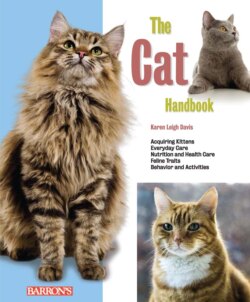Читать книгу The Cat Handbook - Karen Leigh Davis - Страница 19
На сайте Литреса книга снята с продажи.
Colors and Patterns
ОглавлениеFor show purposes, colors are grouped by division and include solids, silvers, shadeds and smokes, colorpoints, tabbies, particolors, and bi-colors. Solids are sometimes referred to as self colors. Tabbies have a pattern of stripes, patches, and bars. Silvers, shadeds, smokes have darker-tipped hairs lying against a paler ground color or undercoat color, which gives the coat a contrasting, shimmering effect, especially when the cat moves and the fur parts. Particolor is a broad term for a coat of two or more colors, such as a tortoiseshell, which is black with patches of red. A bi-color has a coat of two colors, one of which is white.
While many purebreds are bred specifically for their coloring, all of the beautiful colors, patterns, and markings that can be maintained by selective breeding can also appear randomly in the mixed genetic bag that makes up our treasured stock of nonpedigreed, domestic cats. And even though our modern-day domestic cats come in varying coat lengths, colors, and color patterns, they all are genetically tabbies, like their wild African ancestors. The term “tabby” commonly refers to the familiar striped color pattern, not to a specific breed. The pattern occurs in purebred and random-bred cats.
Bars and stripes: Most people recognize the tabby as a cat that has pronounced stripes and bars on its coat, tail, and legs, and frown marks that form an intricate “M” on the forehead.
• The classic or blotched tabby has wide stripes, swirls, patches or blotches, often forming a recognizable bull’s-eye pattern on the sides.
• The more common mackerel tabby has thinner stripes running from the backbone down the sides resembling fish ribs, hence the name.
• The rare spotted tabby, as the name implies, sports spots instead of stripes. The stripes are actually there, but they are broken in places so that they resemble spots.
The agouti pattern: There also are tabbies with no stripes at all. The Abyssinian and Somali breeds represent a unique form of tabby without stripes called the agouti pattern. These two closely related breeds—one a shorthaired type, the other a longhair—are noted for their reddish brown hair ticked with bands of darker color. The ticking, or agouti pattern, results from alternating light- and dark-colored bands on each hair shaft, giving the coat a delicately flecked appearance. The pattern occurs in some other species as well, as in squirrels, and serves as excellent camouflage.
Tabby colors: Of the tabby varieties, the most common colors are the red tabby (sometimes called orange, yellow, or ginger), which bears deep, rich red markings against a lighter red or yellow ground color; the silver or gray tabby, which sports black stripes against a silver or gray background; and the brown tabby, which has black markings on a reddish brown background.
But if all cats are genetically tabbies, how did we end up with the plethora of colors and patterns we see in domestic cats today? Well, over time, genetic changes have occurred that, depending on how genes are arranged in a particular individual, may result in masking or suppressing the distinctive tabby markings; yet, some variation of the tabby gene remains present in all cats. If a cat inherits genes that completely mask the stripes and bars, he will be a self or solid color, such as solid black, for example. But underneath, the cat is still a tabby.
Dilute colors: Generally speaking, dominant genes tend to produce darker, denser colors, such as black or red (also called orange), while recessive genes, in the right combination, will produce dilute colors that are paler than their dominant counterparts. For example, the color gray, which cat fanciers call blue, is the recessive or dilute form of black. Likewise, a cream-colored cat is a paler shade of dominant red.
Spots and patches: There are many patterns that produce interesting color combinations in cats. A common genetic occurrence referred to as the white spotting factor randomly applies splashes of white to the face, feet, and belly, or, in the case of the calico cat, draws dramatic white patches among intermingling blotches of black and orange. Interestingly, calicos and tortoiseshells, which have a patchwork of black and orange blotches like the calico, but without the white, are nearly always females. The lovely patchwork of black and orange is a sex-linked trait produced by genes carried on the female (XX) chromosomes (page 176).
Colorpoints: The pointed pattern, characterized by darker points on the cat’s face, tail, feet, and ears against a lighter body color, predictably appears in certain purebred cats, such as the Siamese, the Himalayan, the Birman, the Ragdoll, the Balinese, and the Snowshoe. This recessive trait is also known as the Himalayan pattern, named after the Himalayan rabbits that sport the same coloration. It is frequently called the Siamese pattern, too, and while perhaps best known because of Siamese purebreds, the pattern occasionally crops up in random-bred cats as well. Cat fanciers often refer to cats with these markings as colorpoints. The gene that produces the pointed pattern is linked with another trait that produces the blue eye color common in the colorpoint breeds.
Interestingly, pointed kittens are born looking nearly white. Their points gradually darken with age. Cooler temperatures influence the pigmentation and darkening process as well, which, experts say, explains why kittens remain light-colored until they exit their mother’s warm womb. After birth, the extremities normally stay a degree or two cooler than the body’s core, so these furthermost points tend to darken more.
